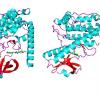Yeah, I was just responding to trip96's question about it. Plus, it gets included in some pro-energy supplements, so it's good to know what it does.
Eur J Pharmacol. 1992 Apr 29;215(1):17-22.
Effect of different subtypes of cognition enhancers on long-term potentiation in the rat dentate gyrus in vivo.
,,,
The higher doses of the two latter drugs, administered 5 min before tetanic stimulation, induced a significant potentiation of LTP, whereas a significant inhibition of LTP was obtained when the drugs were administered 30 min before tetanic stimulation. Based on the results obtained from guinea pig hippocampal slices, an LTP-potentiating effect of all compounds tested could have been anticipated, but this was not supported by our data. The apparent contradiction between the in vivo and in vitro results is discussed. PMID:1516646
So the effect lasts less than 30 minutes and causes inhibition of LTP afterwards. Doesn't sound like it's particularly better than what we've already got in the stack.
Quote
Nihon Yakurigaku Zasshi. 1993 Sep;102(3):225-34.
[Pharmacology of long-term potentiation].
...
The production of LTP in the hippocampus is facilitated by many factors such as epidermal growth factor, fibroblast growth factors, somatostatin, M1 receptor agonists and many drugs like anirasetam, bifemelane, idebenone, indeloxazine and vinpocetine, but inhibited by M2-receptor agonists, scopolamine and midazolam. In addition to electrophysiological methods, LTP-like phenomena in 2-deoxyglucose uptake and leucine incorporation can be detected. These LTP phenomena in several animal models will be useful as indices for evaluating facilitatory actions of various compounds on learning/memory functions. PMID:8104851
This is a really old article (1993). Pretty sure this was before CREB/PKA/LTP was discovered.
Here's a later article that's more interesting that says that Vinpocetine increases CREB phosphyloridation in alcohol damaged animals. It's also a full-text.
http://www.ncbi.nlm....pubmed/19680548
PLoS One. 2009 Aug 14;4(8):e6643.
Phosphodiesterase inhibition increases CREB phosphorylation and restores orientation selectivity in a model of fetal alcohol spectrum disorders.
Krahe TE, Wang W, Medina AE.
Source
Department of Anatomy and Neurobiology, Virginia Commonwealth University Medical Center, Richmond, Virginia, USA.
Abstract
BACKGROUND:
Fetal alcohol spectrum disorders (FASD) are the leading cause of mental retardation in the western world and children with FASD present altered somatosensory, auditory and visual processing. There is growing evidence that some of these sensory processing problems may be related to altered cortical maps caused by impaired developmental neuronal plasticity.
METHODOLOGY/PRINCIPAL FINDINGS:
Here we show that the primary visual cortex of ferrets exposed to alcohol during the third trimester equivalent of human gestation have decreased CREB phosphorylation and poor orientation selectivity revealed by western blotting, optical imaging of intrinsic signals and single-unit extracellular recording techniques. Treating animals several days after the period of alcohol exposure with a phosphodiesterase type 1 inhibitor (Vinpocetine) increased CREB phosphorylation and restored orientation selectivity columns and neuronal orientation tuning.
CONCLUSIONS/SIGNIFICANCE:
These findings suggest that CREB function is important for the maturation of orientation selectivity and that plasticity enhancement by vinpocetine may play a role in the treatment of sensory problems in FASD.
PMID: 19680548
This is a good paper that references back to all the research on CREB and neuronal plasticity. I skimmed it and it doesn't really go into the biochemical mechanism of action of Vinpocetine except to say it's a PDE1 inhibitor.




















































